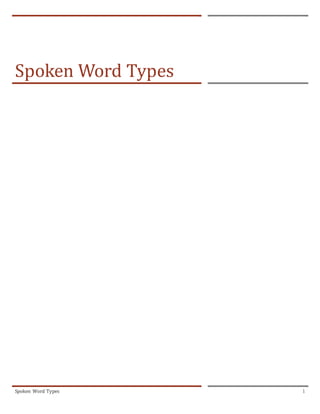
Spoken Word Types
- 1. Spoken Word Types 1 Spoken Word Types
- 2. Spoken Word Types 2 Overview In this lesson, we will discuss the nonverbal cues of a speech and a spoken word poem and go over the different types of spoken word poems. We will also discuss their project. Objectives CCSS.ELA.LITERACY.RL.7.7- Compare and contrast a written story, drama, or poem to its audio, filmed, staged, or multimedia version, analyzing the effects of techniques unique to each medium. CCSS.ELA-LITERACY.SL.7.6- Adapt speech to a variety of contexts and tasks, demonstrating command of formal English when indicated or appropriate. Activities 1. Bellwork: What is Spoken Word Poetry and how is it different from regular poetry? 2. We will read Daniel Beaty’s Knock Knock to introduce themselves to the poem. 3. We will watch Daniel Beaty’s “Knock, Knock” spoken word poem and write down notes of volume, eye contact, facial expressions, movement on their poem. 4. We will write down everything they noticed about the performance on the Smartboard and discuss how those elements impact the performance. 5. We will do a Popcorn Performance: Students will be the prompt of life in a math class. They will write three lines about their life in a math class. One at a time, they will stand up say one line they wrote, incorporating the nonverbal elements we noticed in ‘Knock, Knock’. This will go on until each person has said all three lines. 6. I will talk to the students about their upcoming Spoken Word assignment. In that assignment, they are to write a Spoken Word poem and then perform at our class poetry read. 7. Upon learning about the assignment, I will talk to them about the different types of poems they can do, showing a Youtube video example of one of the poems (Duet poem) , and demonstrating the other with a student (Back and Forth). Adaptations The written poem could be translated into the language of my English Language Learners. If there is a student with a speech impediment, then they can have the option to say 1-2 lines during the Popcorn Performance. Those who have trouble seeing the board may sit closer to the front and receive printed notes of the notes taken about the videos. Materials ‘Knock, Knock video’ ‘Sons’ Video.
- 3. Spoken Word Types 3 Evaluation They will write down on a piece of paper the name of one type of Spoken Word poem we talked about (Knock, Knock would be considered a solo) and describe what it is. Bibliography Beaty, D. (2005). “Knock, knock” Def Jam Poetry. Retrieved from http://genius.com/Daniel-beaty-knock-knock-lyrics Brown, A & Otuteye M. “The bread loaf school of English: Toolkit for teaching spoken word & slam poetry. Retrieved from: www.mvrhs.org/englishdept/shark/.../Teaching%20Slam%20Poetry.doc Button Poetry. (2013, September 19.) Terisa Siagatonu & Rudy Francisco – “Sons” https://www.youtube.com/watch?v=JNPaoszr11U SpokenPoetryTV (2013, May 29). Daniel Beaty- knock knock on dej jam poetry. Retrieved from: https://www.youtube.com/watch?v=HXQ2eRHklDc